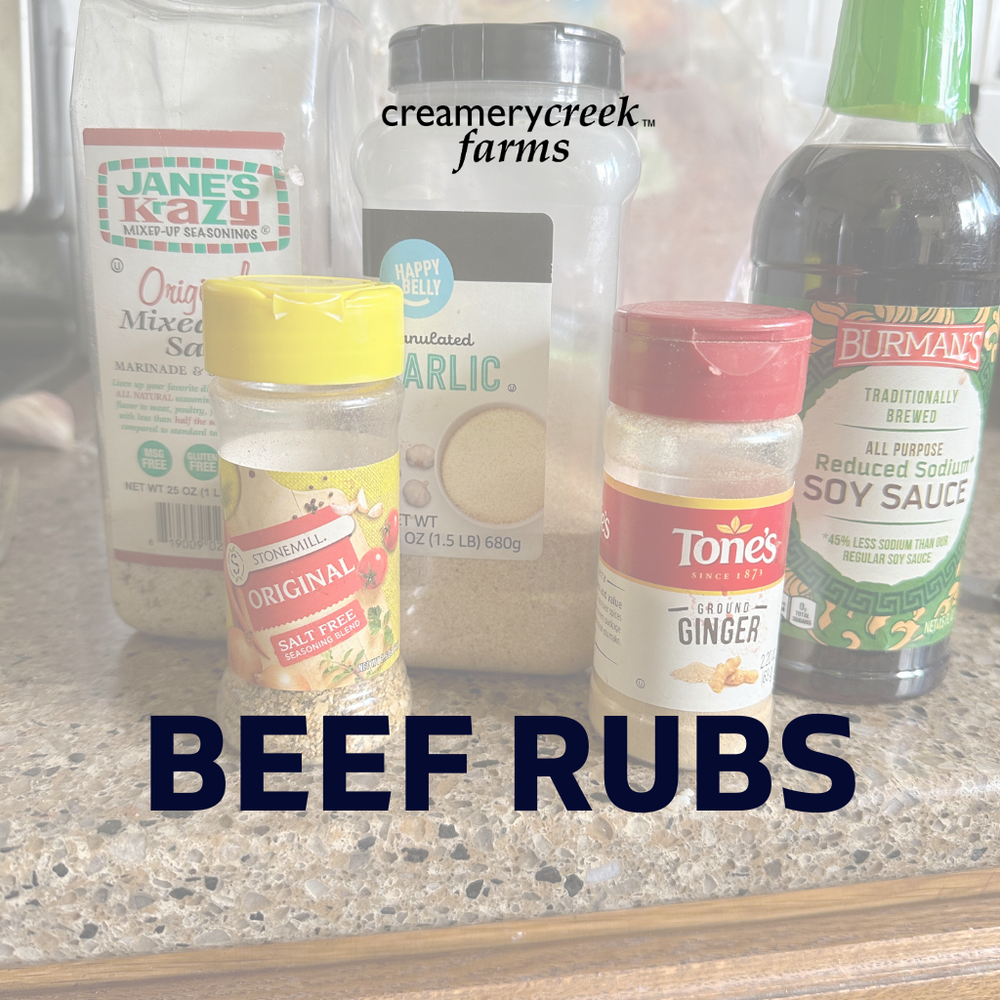
Big bones deserve big flavor.
Beef back ribs, short rib plates, and dino bones aren’t the kind of cuts you quietly slip into the oven on a Tuesday night. They’re statement pieces. When you put them on the grill or smoker, you’re saying, this is dinner and it’s going to be good.
The secret to getting that “wow” bite every time? A good rub.
The Basics of a Good Rub
A rub doesn’t have to be complicated. Don’t overthink it. Start with salt, add a little sweet, then decide what kind of ‘kick’ you want.
Salt – It pulls out flavor and helps the meat hold onto moisture.
Sugar – It caramelizes on the grill, giving you those dark, sticky edges.
Spices – This is where you bring in smoke, heat, or herbs.
That’s it. Don’t overthink it. Start with salt, add a little sweet, then decide what kind of “kick” you want.
Flavor Profiles to Try
I do not have a giant spice cupboard, but we do have the basics. You can succeed with what you have and maybe only pick up one or two more. Estimate about 1 tablespoon of rub per pound of meat on the conservative side, and double that for my favorite amount, and triple that for Justin's favorite amount. You get the idea, your mileage may vary!
Classic BBQ Rub – brown sugar, paprika, garlic, onion, black pepper. Sweet and smoky, perfect for back ribs. (Using the conservative amounts above, one tablespoon of each of these flavors would lightly season a 5lb cut of meat.)
Savory Herb Rub – salt, cracked pepper, rosemary, thyme, garlic powder. A little more “Sunday supper” than “backyard smoke.”
Spicy Kick Rub – Start with the classic BBQ rub and add chili powder, cayenne, smoked paprika.
Coffee & Cocoa Rub – Start with the classic BBQ rub and add a spoonful of instant coffee, cocoa powder, black pepper. Sounds unusual, tastes amazing on short ribs or chuck rib dino bones.
These are jumping-off points. You don’t have to measure everything to the gram, I sure don't! Just build around those three basics and trust your taste buds.
How to Apply a Rub
A few quick tips to make your rubs work their best:
Pat the beef dry first. Moisture makes it harder for the rub to stick.
Don’t be shy. Big bones can handle a heavy hand with seasoning.
Let it sit. Even 30 minutes on the counter helps, but if you’ve got time, let it rest overnight in the fridge.
Rubs aren’t just for smoking. They work great on the grill, in the oven, or even in a braise.
Pairing Rubs with the Big Cuts
Different bones shine with different flavors:
Back Ribs – go with the sweet and smoky BBQ rub. That caramelized bark is half the fun.
Short Rib Plates – rich enough to carry bolder spices like chili, cumin, or even that coffee rub.
Dino Bones (Chuck Ribs) – these big guys can handle adventurous flavors. Load them up with herbs, black pepper, or espresso and watch them impress.
A Little Sneak Peek from the Farm
Here at Creamery Creek, we’ve been tinkering with our own seasoning blends, something we’re calling creekdust. They’re still in the hopper, so I’m not spilling the recipe just yet. But let’s just say we’ve had a lot of fun in the kitchen “taste testing” for you.
In the meantime, grab some beef bones, mix up a rub, and get that grill going. There’s no wrong way to rub beef, just start simple, make it flavorful, and enjoy the showpiece cuts that make your cookouts worth the work.
Tell me how it goes for you!
XOXO,
Louisa



Dejar un comentario
Ver artículo completo
The Church Method for Perfect Beef Roasts
There is a whole world of cooking that never made it into cookbooks. It lives in church basements and community halls where somebody’s aunt has been feeding a crowd for decades and never once owned a digital thermometer. The “church basement method” is simple. Multiply the weight of your roast by time, set the oven to a steady low heat, and follow one important rule. Don’t peek.
It works with everyday beef roasts like sirloin tip, chuck, rump, and top round, which means you do not need a prime rib to put something special on the table.
Ver artículo completo
Slow Cooker Meals for Busy Farm Nights
When chores run late and the weather turns cool, nothing beats a slow cooker meal waiting at the end of the day. Here are our favorite Creamery Creek cuts and easy ideas for fall and winter suppers that cook themselves while you work.
Ver artículo completo
Sweet & Tangy Holiday Meatballs (Farmhouse Appetizer Recipe)
There’s always that one dish that disappears first at every holiday party and these little meatballs are it. Made with our own Creamery Creek Meatball Mix (a blend of dry-aged beef, Duroc pork, and just the right touch of onion), this recipe brings that cozy, sweet-and-smoky flavor everyone loves. A quick toss in sweet fruit jam and BBQ sauce blend, a brush under the broiler, and you’ve got the perfect farmhouse appetizer for the season.
Ver artículo completo